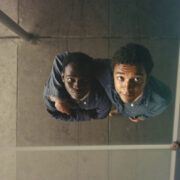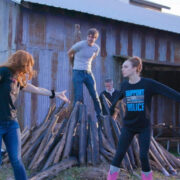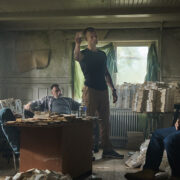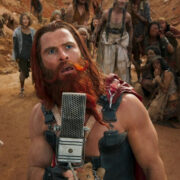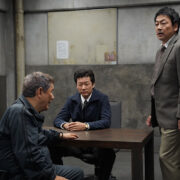THE MAN FROM U.N.C.L.E.: Blindingly Stylish

Alistair is a 25 year old writer based in Cambridge.…
Even though he’s often stereotyped as solely a director of inferior British gangster films, based on his first two releases Lock, Stock and Two Smoking Barrels and Snatch, Guy Ritchie is actually more of an experimental director than you may initially realise. Even though his early films were successful and enjoyable guilty pleasures, Ritchie had something of an insatiable need to be taken seriously, looking towards the European arthouse for inspiration. His third feature Swept Away, starring his then wife Madonna, was a remake of a satirical 1974 Italian film not widely known to international audiences. By choosing to remake it, he would both show his world cinema knowledge and prove that he could easily make films in genres that don’t involve gangsters.
A Film That Marries Populism With New Wave Style
When that film turned into one of the biggest critical and commercial flops of the new millennium, he retreated back to the gangster safety net with Revolver. Only this time, trying to prove his intellectual and arthouse credentials in a genre far removed from either, he would be dealing heavily with themes relating to Kabbalah, due to an interest in the religion whilst writing the movie. Again, this isn’t something that fits in nicely with the type of gangster movie Ritchie was known for making, resulting in a second bizarre failure as a direct result of trying to experiment. Only now, having departed the gangster genre once and for all with two mightily enjoyable Sherlock Holmes films, can Ritchie begin experimenting again.
Instead of trying to force experimental style into the screenplay, which in Ritchie’s heavy handed writing prose usually means confusing it beyond all sense of comprehension, here he is adapting for the screen a classic American TV series, giving him a sense of structure when it comes to writing the screenplay. With a firm espionage narrative established, Ritchie takes great delight in experimenting visually, and for the first time in his career, it pays off. Never would I have imagined I would have walked out of a Guy Ritchie movie claiming that it had a clear influence from the French New Wave, yet here is The Man from U.N.C.L.E., a film so blindingly stylish at times you don’t comprehend the lack of substance until long after you’ve seen it.

It is the 60’s and the Cold War is in full swing. In East Berlin, suave agent Napoleon Solo (Henry Cavill) is trying to stop an international criminal organisation that are secretly making nuclear weapons. His only lead is Gaby Teller (Alicia Vikander), the daughter of a German scientist who vanished; upon trying to break her out of East Berlin, they are followed by Illya Kuryakin (Armie Hammer), a KGB agent under orders to stop her from leaving the country. A manic action set piece ensues, which includes Hammer ripping off parts of a moving car with his bare hands, concluding with Solo and Teller making their way to the safety blanket of the West.
The next day, Solo is told that the East and West are to team up to stop the organisation once and for all, which means partnering with the man who tried to kill him only hours before and heading to Italy undercover, something that is hard for Illya to do, due to his violent temper. Thankfully, the inclusion of Vikander’s character ensures the movie never resorts to a simplistic odd couple routine between the two characters. At a time when East and West relations at their worst since the Cold War, it is nice to see the film refusing to fall back on easy stereotypes. In fact, the running joke of Illya struggling to stay undercover seems engineered solely to overturn many of them.
As this is a film engineered on style, there isn’t a lot to say about the performances, although for the first time in his career, Henry Cavill delivers an entertaining performance and actually proves to be a thrilling screen presence, something I wouldn’t have believed was possible following bland turns in Man of Steel and Immortals. He plays the role of Napoleon Solo like a classic Hollywood leading man, with the sexual appetite of a Connery-era Bond; despite sex hovering omnipresent in the background at all times in the same way it does in the earliest 007 outings, the movie is remarkable in that it never comes across as sexist. Instead, the heavy stylisation of the film as a whole helps it transcend into glamour, something that Bond’s quick romps can never be confused for. On a narrative level, the movie does resemble an unashamed attempt to make a major Hollywood action picture in the same vein as the espionage pictures of old. But on a visual and purely visceral level, it is remarkable how much inspiration has been taken from the golden age of the European arthouse – the 60’s new wave, that challenged movie conventions and helped alter the language of cinema.
An Unconventional Action Movie
From the opening seconds, as an old-fashioned Warner Bros. logo appears accompanied by an ever-present jazz soundtrack, the movie frequently moves from classic Hollywood action to unconventional framing techniques and, more importantly, unusual staging of central moments. For example, in this film Ritchie repeatedly grounds something mundane in the centre of the screen, leaving the more important element of the frame out of focus; as Armie Hammer is having a speedboat shootout, we are instead watching Henry Cavill messing with a car radio and eating a sandwich. The scene isn’t played for laughs, as this is a movie too cool for the broad comedy that characterises blockbusters. Similarly, as Armie Hammer sits with his head in his hands in the hotel room, Alicia Vikander is vibrantly dancing in the background, out of focus, for quite some time before the attention turns to her. It is an unusual, but somewhat inspired decision, to concentrate on the emotional reactions of the people not involved with the action whilst the action is unfolding right next to them, indifferently.

It helps separate the film from the visual style of similar Hollywood blockbusters – and uniquely for Ritchie, doesn’t confuse the narrative. He keeps the style separate from the substance at all times, even though both are present in the film. Elsewhere, he uses jump cuts, Wes Anderson-inspired 90 degree camera turns in the middle of the scene, and in one scene (as we see subtitles for lips we can see but not hear behind a car window), a Jean-Luc Godard-inspired use of sound editing. I have to remind you that this is a $75 million, major studio tentpole, Guy Ritchie-directed movie that is the source for these cinematic references.
Conclusion
This isn’t to say that all the action plays in such an obtuse way; in fact, the movie has so many action sequences, Ritchie needed to utilise different methods in order for the film to remain visually interesting throughout. Even in the more conventional sequences, such as the opening chase sequence, there is so much attention packed into the frame, ensuring it rewards multiple viewings in ways that many films that have a higher percentage of style than substance don’t. The Man From U.N.C.L.E. is thrilling in a way few action movies are, and certainly far more thrilling than anything Ritchie has directed up until this point.
What did you think of The Man From U.N.C.L.E.? What are your favourite TV show to film adaptations?
The Man from U.N.C.L.E. is out now in the UK and US. All international release dates can be found here.
(top image source: Warner Bros. Pictures)
Does content like this matter to you?
Become a Member and support film journalism. Unlock access to all of Film Inquiry`s great articles. Join a community of like-minded readers who are passionate about cinema - get access to our private members Network, give back to independent filmmakers, and more.
Alistair is a 25 year old writer based in Cambridge. He has been writing about film since the start of 2014, and in addition to Film Inquiry, regularly contributes to Gay Essential and The Digital Fix, with additional bylines in Film Stories, the BFI and Vague Visages. Because of his work for Film Inquiry, he is a recognised member of GALECA, the Gay & Lesbian Entertainment Critics' Association.


